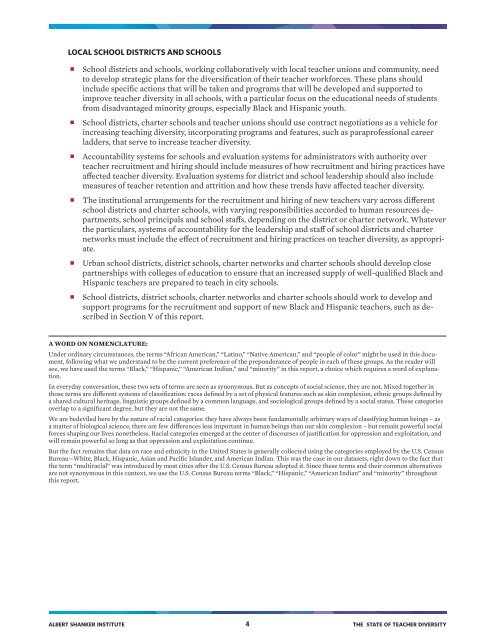TEACHER DIVERSITY
The State of Teacher Diversity_0
The State of Teacher Diversity_0
- No tags were found...
You also want an ePaper? Increase the reach of your titles
YUMPU automatically turns print PDFs into web optimized ePapers that Google loves.
LOCAL SCHOOL DISTRICTS AND SCHOOLS<br />
■■<br />
■■<br />
■■<br />
■■<br />
■■<br />
■■<br />
School districts and schools, working collaboratively with local teacher unions and community, need<br />
to develop strategic plans for the diversification of their teacher workforces. These plans should<br />
include specific actions that will be taken and programs that will be developed and supported to<br />
improve teacher diversity in all schools, with a particular focus on the educational needs of students<br />
from disadvantaged minority groups, especially Black and Hispanic youth.<br />
School districts, charter schools and teacher unions should use contract negotiations as a vehicle for<br />
increasing teaching diversity, incorporating programs and features, such as paraprofessional career<br />
ladders, that serve to increase teacher diversity.<br />
Accountability systems for schools and evaluation systems for administrators with authority over<br />
teacher recruitment and hiring should include measures of how recruitment and hiring practices have<br />
affected teacher diversity. Evaluation systems for district and school leadership should also include<br />
measures of teacher retention and attrition and how these trends have affected teacher diversity.<br />
The institutional arrangements for the recruitment and hiring of new teachers vary across different<br />
school districts and charter schools, with varying responsibilities accorded to human resources departments,<br />
school principals and school staffs, depending on the district or charter network. Whatever<br />
the particulars, systems of accountability for the leadership and staff of school districts and charter<br />
networks must include the effect of recruitment and hiring practices on teacher diversity, as appropriate.<br />
Urban school districts, district schools, charter networks and charter schools should develop close<br />
partnerships with colleges of education to ensure that an increased supply of well-qualified Black and<br />
Hispanic teachers are prepared to teach in city schools.<br />
School districts, district schools, charter networks and charter schools should work to develop and<br />
support programs for the recruitment and support of new Black and Hispanic teachers, such as described<br />
in Section V of this report.<br />
A WORD ON NOMENCLATURE:<br />
Under ordinary circumstances, the terms “African American,” “Latino,” “Native American,” and “people of color” might be used in this document,<br />
following what we understand to be the current preference of the preponderance of people in each of these groups. As the reader will<br />
see, we have used the terms “Black,” “Hispanic,” “American Indian,” and “minority” in this report, a choice which requires a word of explanation.<br />
In everyday conversation, these two sets of terms are seen as synonymous. But as concepts of social science, they are not. Mixed together in<br />
those terms are different systems of classification: races defined by a set of physical features such as skin complexion, ethnic groups defined by<br />
a shared cultural heritage, linguistic groups defined by a common language, and sociological groups defined by a social status. These categories<br />
overlap to a significant degree, but they are not the same.<br />
We are bedeviled here by the nature of racial categories: they have always been fundamentally arbitrary ways of classifying human beings – as<br />
a matter of biological science, there are few differences less important in human beings than our skin complexion – but remain powerful social<br />
forces shaping our lives nonetheless. Racial categories emerged at the center of discourses of justification for oppression and exploitation, and<br />
will remain powerful so long as that oppression and exploitation continue.<br />
But the fact remains that data on race and ethnicity in the United States is generally collected using the categories employed by the U.S. Census<br />
Bureau—White, Black, Hispanic, Asian and Pacific Islander, and American Indian. This was the case in our datasets, right down to the fact that<br />
the term “multiracial” was introduced by most cities after the U.S. Census Bureau adopted it. Since these terms and their common alternatives<br />
are not synonymous in this context, we use the U.S. Census Bureau terms “Black,” “Hispanic,” “American Indian” and “minority” throughout<br />
this report.<br />
ALBERT SHANKER INSTITUTE 4 THE STATE OF <strong>TEACHER</strong> <strong>DIVERSITY</strong>


